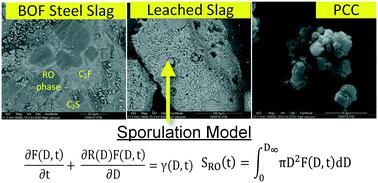当前位置:
X-MOL 学术
›
React. Chem. Eng.
›
论文详情
Our official English website, www.x-mol.net, welcomes your feedback! (Note: you will need to create a separate account there.)
A review on steel slag valorisation via mineral carbonation
Reaction Chemistry & Engineering ( IF 3.9 ) Pub Date : 2021-5-25 , DOI: 10.1039/d1re00035g Raghavendra Ragipani 1, 2, 3, 4, 5 , Sankar Bhattacharya 5, 6, 7, 8 , Akkihebbal K. Suresh 2, 3, 4, 5
Reaction Chemistry & Engineering ( IF 3.9 ) Pub Date : 2021-5-25 , DOI: 10.1039/d1re00035g Raghavendra Ragipani 1, 2, 3, 4, 5 , Sankar Bhattacharya 5, 6, 7, 8 , Akkihebbal K. Suresh 2, 3, 4, 5
Affiliation

|
Research pertaining to carbon dioxide sequestration via mineral carbonation has gained significant attention, primarily due to the stability of sequestered CO2 over geological time scales. The use of industry-derived alkaline wastes as feedstocks for mineral carbonation also provides an opportunity for waste valorisation. In this review, we describe the carbonation of steel slag, a calcium-rich solid waste from iron and steel industries, whose current utilisation is below par in major crude steel-producing countries. We review ex situ mineral carbonation routes, both direct and indirect, which produce weathered aggregates suitable for the construction industry and value-added chemicals such as precipitated calcium carbonate, respectively. We present an in-depth analysis of slag characteristics and its implications for dissolution and carbonation mechanisms. Current research efforts are focused on overcoming slow carbonation kinetics under atmospheric conditions. However, a good understanding of the rate limiting step and the role of product layers in reaction kinetics is incomplete and evolving. In this review, we summarize the experimental research efforts in understanding the rate limiting step and enhancement strategies for various process routes proposed in the literature. Steel slags are chemically heterogeneous residues and pose significant challenges in modelling the dissolution kinetics. To determine the controlling mechanism using models, it is necessary to model the competitive behaviour of ions during dissolution and precipitation, temporal evolution of the reactive surface area, and coupling of the surface reaction and mass transport at the fluid–solid interface. We present mathematical models that describe the surface reaction, role of polydispersity and heterogeneous morphology in determining reactive surface area evolution, and briefly inform the readers about the non-equilibrium thermodynamics approach for modelling coupled processes. Finally, the current state-of-art in reactor technologies and a step forward for commercialisation are commented on.
中文翻译:

矿物碳化使钢渣增值的研究进展
通过矿物碳化作用封存二氧化碳的研究受到了极大的关注,这主要是由于封存的 CO 2在地质时间尺度上的稳定性。使用工业衍生的碱性废物作为矿物碳酸化的原料也为废物增值提供了机会。在这篇综述中,我们描述了钢渣的碳化,钢渣是一种来自钢铁工业的富含钙的固体废物,目前其利用率低于主要粗钢生产国的标准。我们异地审查直接和间接的矿物碳酸化路线,分别生产适用于建筑行业的风化骨料和增值化学品,如沉淀碳酸钙。我们深入分析了炉渣特性及其对溶解和碳化机制的影响。目前的研究工作集中在克服大气条件下的缓慢碳酸化动力学。然而,对限速步骤和产物层在反应动力学中的作用的充分理解是不完整的和不断发展的。在这篇综述中,我们总结了在理解文献中提出的各种工艺路线的限速步骤和增强策略方面的实验研究工作。钢渣是化学异质残留物,对溶解动力学建模提出了重大挑战。为了使用模型确定控制机制,有必要对溶解和沉淀过程中离子的竞争行为、反应表面积的时间演变以及流固界面处的表面反应和传质耦合进行建模。我们提出了描述表面反应、多分散性和非均相形态在确定反应表面积演变中的作用的数学模型,并简要介绍了用于模拟耦合过程的非平衡热力学方法的读者。最后,评论了反应堆技术的当前状态和商业化的进步。为了使用模型确定控制机制,有必要对溶解和沉淀过程中离子的竞争行为、反应表面积的时间演变以及流固界面处的表面反应和传质耦合进行建模。我们提出了描述表面反应、多分散性和非均相形态在确定反应表面积演变中的作用的数学模型,并简要介绍了用于模拟耦合过程的非平衡热力学方法的读者。最后,评论了反应堆技术的当前状态和商业化的进步。为了使用模型确定控制机制,有必要对溶解和沉淀过程中离子的竞争行为、反应表面积的时间演变以及流固界面处的表面反应和传质耦合进行建模。我们提出了描述表面反应、多分散性和非均相形态在确定反应表面积演变中的作用的数学模型,并简要介绍了用于模拟耦合过程的非平衡热力学方法的读者。最后,评论了反应堆技术的当前状态和商业化的进步。流固界面表面反应和传质的耦合。我们提出了描述表面反应、多分散性和非均相形态在确定反应表面积演变中的作用的数学模型,并简要介绍了用于模拟耦合过程的非平衡热力学方法的读者。最后,评论了反应堆技术的当前状态和商业化的进步。流固界面表面反应和传质的耦合。我们提出了描述表面反应、多分散性和非均相形态在确定反应表面积演变中的作用的数学模型,并简要介绍了用于模拟耦合过程的非平衡热力学方法的读者。最后,评论了反应堆技术的当前状态和商业化的进步。
更新日期:2021-06-17
中文翻译:

矿物碳化使钢渣增值的研究进展
通过矿物碳化作用封存二氧化碳的研究受到了极大的关注,这主要是由于封存的 CO 2在地质时间尺度上的稳定性。使用工业衍生的碱性废物作为矿物碳酸化的原料也为废物增值提供了机会。在这篇综述中,我们描述了钢渣的碳化,钢渣是一种来自钢铁工业的富含钙的固体废物,目前其利用率低于主要粗钢生产国的标准。我们异地审查直接和间接的矿物碳酸化路线,分别生产适用于建筑行业的风化骨料和增值化学品,如沉淀碳酸钙。我们深入分析了炉渣特性及其对溶解和碳化机制的影响。目前的研究工作集中在克服大气条件下的缓慢碳酸化动力学。然而,对限速步骤和产物层在反应动力学中的作用的充分理解是不完整的和不断发展的。在这篇综述中,我们总结了在理解文献中提出的各种工艺路线的限速步骤和增强策略方面的实验研究工作。钢渣是化学异质残留物,对溶解动力学建模提出了重大挑战。为了使用模型确定控制机制,有必要对溶解和沉淀过程中离子的竞争行为、反应表面积的时间演变以及流固界面处的表面反应和传质耦合进行建模。我们提出了描述表面反应、多分散性和非均相形态在确定反应表面积演变中的作用的数学模型,并简要介绍了用于模拟耦合过程的非平衡热力学方法的读者。最后,评论了反应堆技术的当前状态和商业化的进步。为了使用模型确定控制机制,有必要对溶解和沉淀过程中离子的竞争行为、反应表面积的时间演变以及流固界面处的表面反应和传质耦合进行建模。我们提出了描述表面反应、多分散性和非均相形态在确定反应表面积演变中的作用的数学模型,并简要介绍了用于模拟耦合过程的非平衡热力学方法的读者。最后,评论了反应堆技术的当前状态和商业化的进步。为了使用模型确定控制机制,有必要对溶解和沉淀过程中离子的竞争行为、反应表面积的时间演变以及流固界面处的表面反应和传质耦合进行建模。我们提出了描述表面反应、多分散性和非均相形态在确定反应表面积演变中的作用的数学模型,并简要介绍了用于模拟耦合过程的非平衡热力学方法的读者。最后,评论了反应堆技术的当前状态和商业化的进步。流固界面表面反应和传质的耦合。我们提出了描述表面反应、多分散性和非均相形态在确定反应表面积演变中的作用的数学模型,并简要介绍了用于模拟耦合过程的非平衡热力学方法的读者。最后,评论了反应堆技术的当前状态和商业化的进步。流固界面表面反应和传质的耦合。我们提出了描述表面反应、多分散性和非均相形态在确定反应表面积演变中的作用的数学模型,并简要介绍了用于模拟耦合过程的非平衡热力学方法的读者。最后,评论了反应堆技术的当前状态和商业化的进步。



























 京公网安备 11010802027423号
京公网安备 11010802027423号